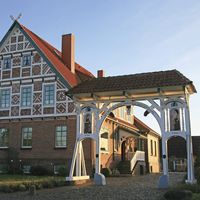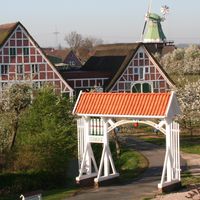Typical ornamented Gates
The Prunkpforten (ornamented gates)
The unique ornamented gates, same as the artistically decorated gables of the Altländer Fachhallenhäuser, are evidence of the craftsmen's skill and artistry and the prosperity and self-confidence of the Altländer as well as their pride in their homeland.
The oldest and most beautiful "Ollanner Puurten", as they are called in Low German, decorate the entrances to farms in Nincop and Liedenkummer in Hamburg's Neuenfelde district, in the third mile of the Altes Land. They were constructed in the late 17 th century. This is exactly the period when the famous organ builder Arp Schnitger lived and worked in Neuenfelde and the church and organ were built. It is said that Arp Schnitger's journeymen crafted the first ornamented gates. The gate of the old Monastery in Buxtehude is supposed to have served as a model. Christian Precht, a carpenter and carver from Hamburg, who created the inventory of the St. Pancratius Church in Neuenfelde in 1683, is also considered to have contributed to the gates.
Probably the oldest ornamented gate is located on the driveway of the Quast farm, Nincoper Straße 45. It gave the estate its name: until today it is called "Puurtenquast" (Pfortenquast). The gate was built in 1683 for the Provost of Finckh. The strong construction made of oak is richly decorated with colourful carvings.
Even though the gates differ in shape and equipment, their construction is always the same. They all have a large passage for wagons and a side opening for pedestrians. A thatched or tiled roof protects the frame work from rain and snow.
The strong thresholds were built on three brick strip foundations. As all other components, they are made of oak wood, which used to be considered very weather-resistant. The three robust frames are mortised into these and each is supported at a stable angle by two foot braces. The mortised plate, which is braced towards the frames, lies here. On top of this is the tiled roof, which is protected against tipping over by three pairs of braces fixed directly onto the frames.
The larger doorway serves as a passage for the wagons. Particularly in the second and third mile, this is covered by a head wood, which is formed as a round arch or as a segmental arch. The smaller door is intended for pedestrians and small vehicles. It is crowned by a wide headpiece and is topped by turned or curved columns which fill the open space between them and the frame. The head wood arch and head end plate are decorated with carvings. The head wood arch is decorated with a banner running over the entire length, which is arranged with rosettes. The head end plate is decorated with a cartridge framed by figures and tendrils. The cartridge contains the name of the farm owner and the year of construction or renovation. A sculptured grape, a symbol of fertility, hangs in the centre under the wooden arch of the wagon passage. On the left and right are lion heads which function as gatekeepers and are supposed to keep uninvited guests and mischief away from the farm. The rich decoration is enhanced by a colourful coating. The frame work is mostly white, in some cases also green coloured. All doorways can be closed using palings.
The ornamented gates were rapidly imitated in the second and first mile until modern times. The ornamented gate at the Rieper Farm in Osterjork No. 22, built in 1906, deviates significantly from the usual design with its three openings, the sculptural decoration above the side passages and the lack of pailings.
The simplest gates can be found in the first mile along the Elbe dyke. One of them is the gate in Twielenfleth, built in 1791, at dyke no. 31, which was replaced in 1959 and re-installed on Stade's Museum Island in 1972.
The Mohr'sche Gate in Mittelkirchen, Location No.17
The ornamented gate with its green frame work was built in 1756. In 1944 it had to be extensively reconstructed. In doing so, the wagon passage was widened. In 1978, another reconstruction took place in which the frame work was extended. Since then, larger vehicles are able to access the farm.



